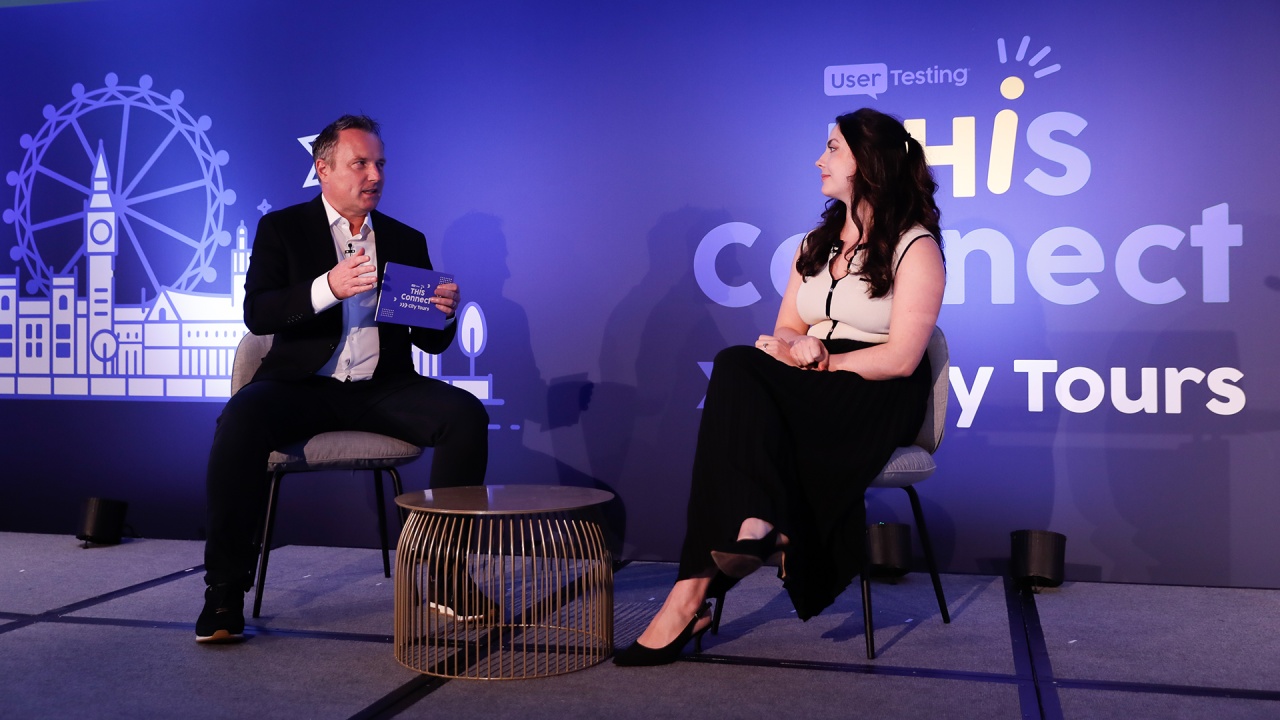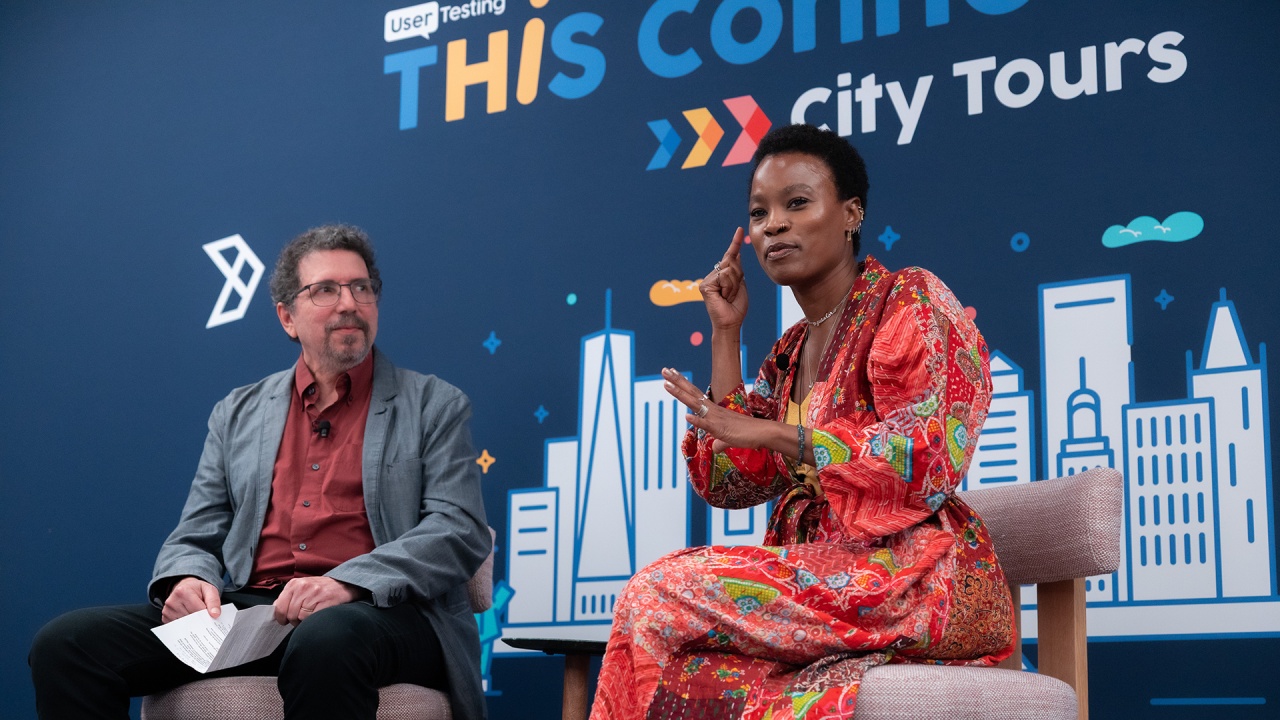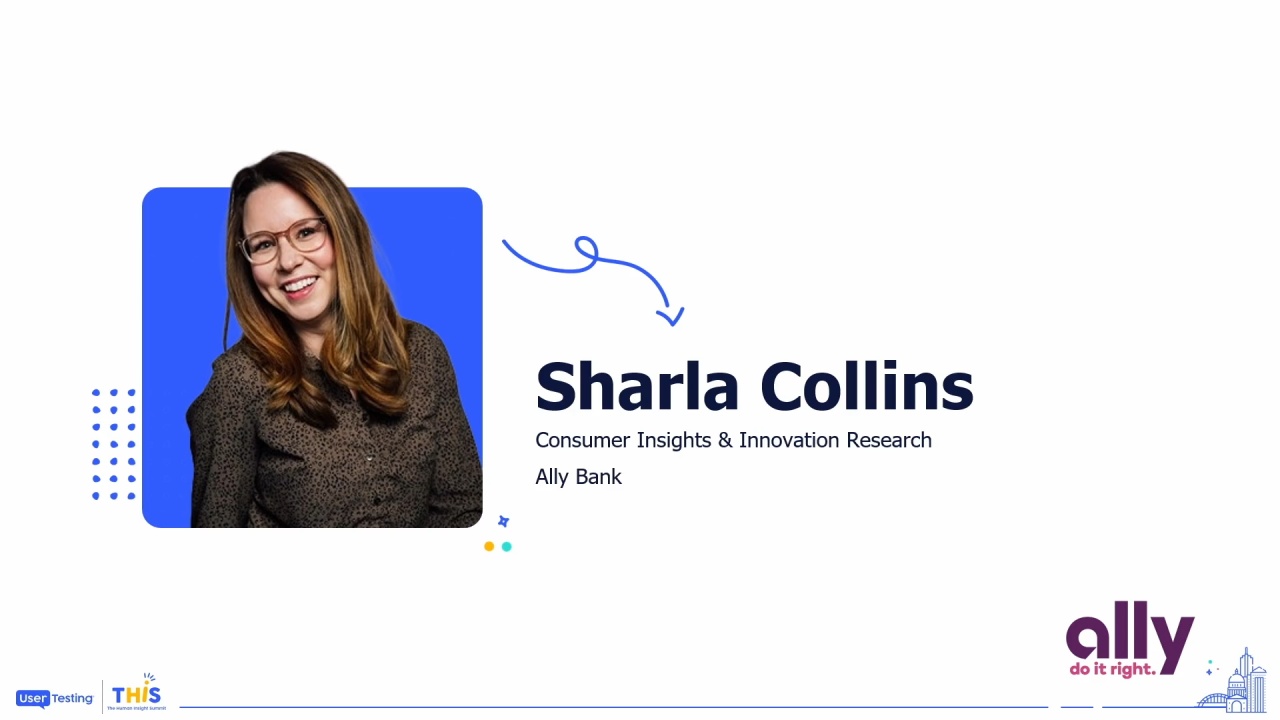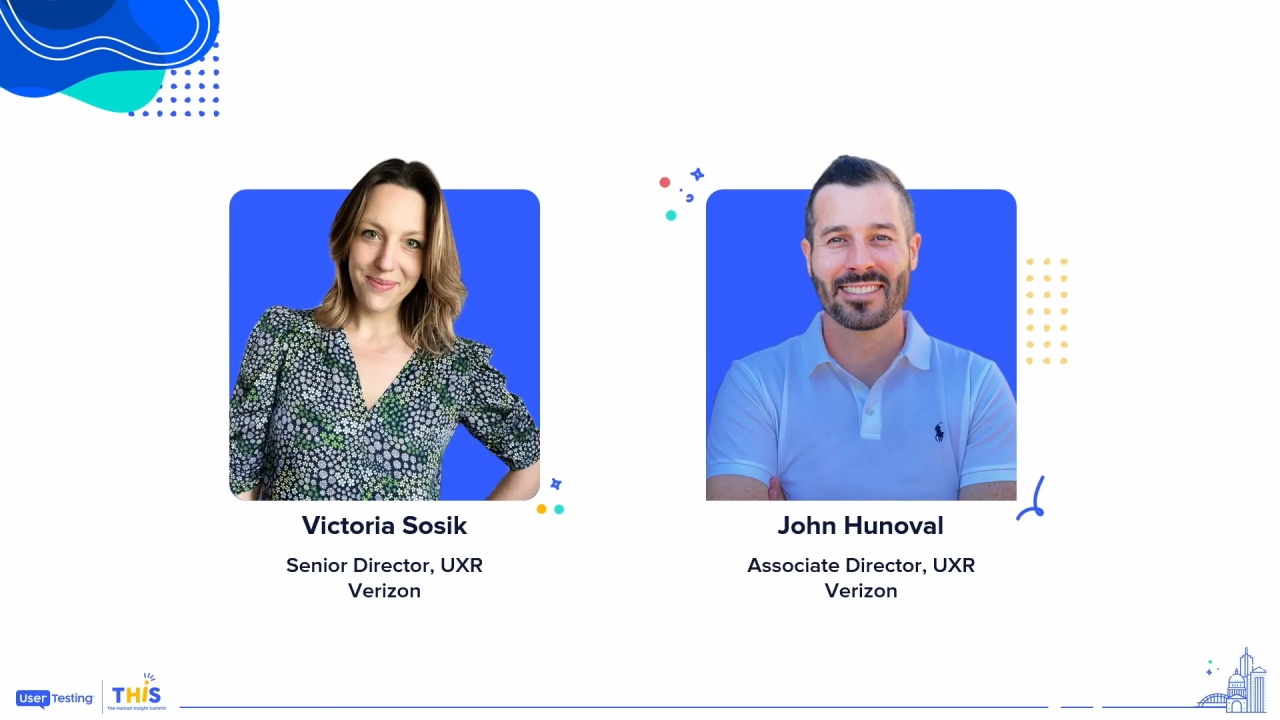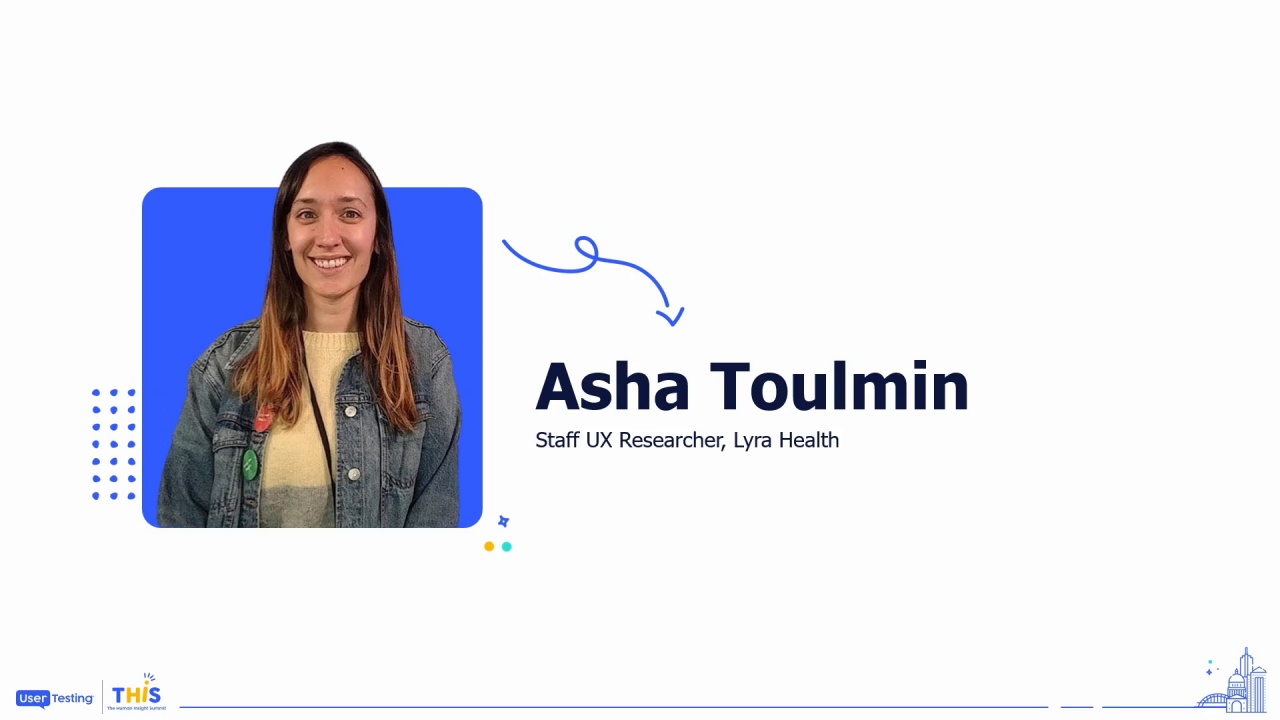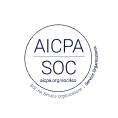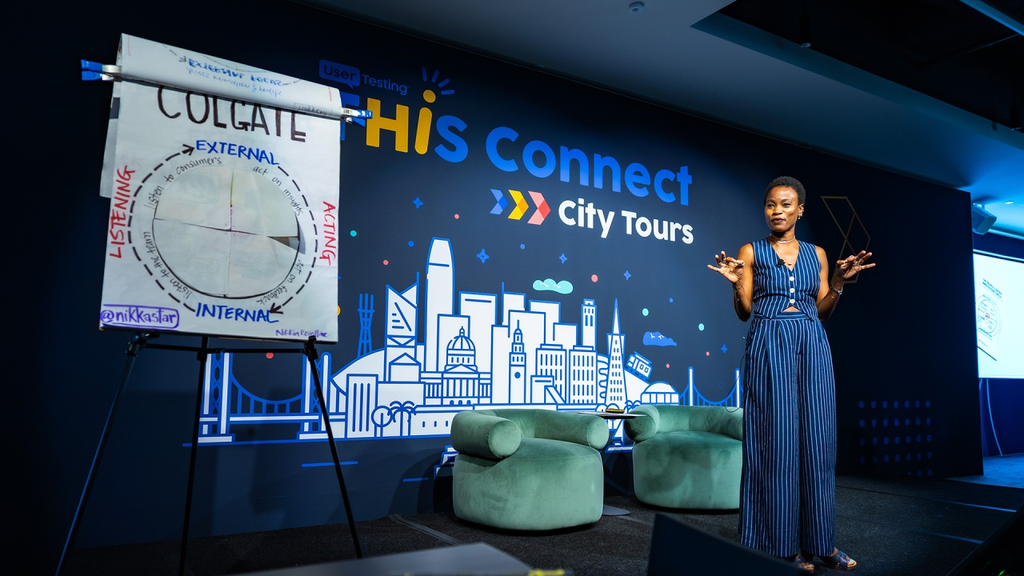
Nikkia Reveillac: Insights are the Heart & Soul of Innovation
Nikkia Reveillac
Former Insights Exec/Keynote Speaker/Host, Netflix, Twitter, and Colgate-Palmolive
Fireside Chat Moderated by Connie Guglielmo
Ex-editor-in-chief, CNET, Forbes, Bloomberg, and Wired
What’s the key to true innovation? While brilliant minds, and great ideas are essential, real breakthroughs happen when you deeply understand your customers’ needs. The joy that comes from creating something that truly makes a difference in people’s lives is unmatched. By keeping these fundamental human truths at the heart of your strategies—whether in product development, design, branding, or marketing—you can make your offerings stand out in an increasingly competitive marketplace.
In this talk, Nikkia Reveillac delves into how you can unlock the power of data and insights to drive innovation. Unlocking consumer insights isn't just for big businesses; it's a journey anyone can embark on with curiosity, empathy, and a willingness to listen.
Next up, I'm actually I'm thrilled to welcome someone who brings a unique and powerful perspective on what truly drives innovation.
Nicky Ryvayak is a seasoned insights leader, who has led teams at Netflix, Twitter and Colgate Palmolive, helping brands turn deep customer impact and understanding into meaningful, impactful experiences.
So in her talk, which is going to be a little unique, I can tell you, she will explore how curiosity, empathy, and a willingness to unlock the kinds of insights that fuel creativity and lasting innovation. So please join me in welcoming Nikki to the stage. Let's go.
Thank...
Next up, I'm actually I'm thrilled to welcome someone who brings a unique and powerful perspective on what truly drives innovation.
Nicky Ryvayak is a seasoned insights leader, who has led teams at Netflix, Twitter and Colgate Palmolive, helping brands turn deep customer impact and understanding into meaningful, impactful experiences.
So in her talk, which is going to be a little unique, I can tell you, she will explore how curiosity, empathy, and a willingness to unlock the kinds of insights that fuel creativity and lasting innovation. So please join me in welcoming Nikki to the stage. Let's go.
Thank you.
Alright.
Now, have you ever heard of a new idea and the first thought that enters your mind when you hear about it is, I absolutely could have thought about that.
You know the, the blanket that you can wear?
Or the Velcro strips that you put behind the painting so that you don't have to bore holes in your wall?
Or better yet, the shoes that you wear that look like feet. No, I'm joking. That's a terrible idea, and whoever came up with that idea should be punished.
Now with so many amazing ideas floating around, why is it that more of them don't break through?
And what is it that distinguishes the ideas that do?
Now, many of us would say that it has to do with things like technology and timing or talent and strategy or marketing, and we wouldn't be wrong.
But I'd argue that while all of those things are necessary, they aren't quite sufficient.
Because the thing that distinguishes those ideas that succeed and the seventy to ninety percent of ideas that fail isn't just about timing or technology.
It has to do with a secret. No, I'm kidding. It's not a secret. It's good old fashioned human understanding.
It's people centricity, yeah.
Because when you put people at the center, breakthroughs happen.
I I I could already see it in some of your faces that you may be thinking, I'm engaged, Nakia, but I'm a little bit skeptical.
In fact, some of you are of you are like, well, like, I'm people obsessed. I love customer understanding. Why else would I be here at user testing's CitiConnect tours?
But here's the thing.
I give these talks a lot, and I often wonder if when I say the word people, and you hear the word people, that we're thinking about the same people.
So today, we'll explore a powerful truth, that I've had the experience of dealing with first hand through many, many years of working in this beautiful field that we all work in.
And that is when you build your entire innovation practice around people, breakthroughs don't just happen once, they become your competitive advantage.
Now, this revelation and this novel way to think about people and people centricity didn't occur to me overnight like an epiphany.
It came after a couple decades of observing this paradox play out across three very different companies in three very different industries.
So at Colgate Palmolive, during the recessionary years o seven through o nine, that hit fast moving consumer products goods companies particularly hard.
Then at Twitter, during the most harrowing chapters of our collective existence, the pandemic years.
And then at Netflix, during the height of the streaming wars, when Netflix was moving from being in a sea of one to all of a sudden being in a sea of many.
And across these diverse environments, the thing that I noticed when these companies produced innovations that tended to succeed was that two things happened to always be true.
The first is that there was this external customer obsession, where every single person in the company obsessed about learning everything that they could about people. But not just the things that people say that they need, but those hidden pinpoints that are often unexpressed and force people to create work around solutions.
The second thing is that there was this internal team culture obsession in which people wanted to create the kinds of environments where diverse perspectives were valued, people could challenge assumptions, and ultimately get the best work of their lives done.
But here's the big idea.
We've been thinking about these two things separately.
Now it's not surprising because external customer obsession, as you've already heard, has this direct link to financial results.
Because ultimately, if you do everything in your power to stay close to the customer and understand their needs, you should be developing innovation that meets the needs that have been unearthed.
And so that direct link to the bottom line makes it obvious. In fact, there are whole conferences dedicated to understanding customers.
Now on the flip side, the internal team culture obsession is often hidden from view.
It's really challenging to understand how the inner workings of a company, the way talent is organized inside of an organization, how decisions are made and rewarded, and all of those things working in tandem to contribute to the bottom line. And so it's not surprising that that elevation is not there.
But the reality is that these two things are not separate.
They are not distinct.
You can't simply focus on one and just, like, hope for the best on the other side.
They are two sides of the very same coin.
They're two dimensions of the very same principle.
And so the magic with these companies is that when you prioritize both, when you focus equally on external customer obsession and internal team culture obsession, and the company, as was said earlier, makes it a top priority to focus on both. That's where the magic happens.
That's where you have your true competitive advantage.
And so when all people are at the center, innovation really does happen.
Now, Mel Robbins has famously said that you have about five seconds before your brain talks you out of a good idea. And so I'm giving you fair warning.
In the next five seconds, I'm gonna introduce you to a framework that may be so intuitive yet powerful that you may ask yourself, why have you been thinking about this in this way for so long?
And so get your pens ready or your phones, whatever it is you like to take notes with.
And in five, four, three, two, one, let me introduce you to my analog people centric innovation circle.
We're at the center, and you can get cozy. After all, we're about to have a fireside chat, and I think back in the days, there was like an actual fireside where you'd come closer. But at the center, we have people, and now you're fully aware that the people that we're talking about are just people. The people that you wish to serve, but also the people that you serve with.
At the top, you have your external focus.
And this is about focusing on understanding as much as you can about the people that you wish to serve, so that ultimately what you're doing is you're driving innovation and profits.
And at the bottom, you have your inward focus. And now friends, this is not about getting spiritual, though there's an element of focusing inward that simply has to do with understanding and loving the humanity and others. But this is your internal focus. It's about understanding and creating and sustaining the kind of conditions inside of your teams and your organizations that allows for productivity and creativity to happen.
And so the magic here is the virtuous cycle that these things create.
Now, on the right side, your left side, we have listening, and on the right side we have acting. And when these elements connect, the intersection creates four powerful quadrants.
So on the top left, we listen to our customers and you hear a lot, you will hear a lot about it today. You've already heard a lot about this today. However you do it, just do it. Because ultimately what we're doing is doing the kind of research and gathering gathering a ton of data and insights that allows us to develop this kind of deep empathy for the people that we wish to serve. So that as we move over to the top right, we're able to develop solutions that meet real human problems unearthed from that research phase.
And then as we move to the left, this is the part that we start to miss. We listen to the team.
And we may not all be able to create the kind of environment in places that we work, where there is this kind of dynamic, but if you have a little bit of power, even in your team, it's important to think about how you can create an environment where people can raise diverse points of view, challenge assumptions, and sometimes raise the kind of dissenting perspective that is going to change the course of a conversation without fear.
And then as you move to the bottom right, it's up to the organization's decision makers to act responsibly by developing solutions that directly address all of these inputs.
I'd love to show you how this plays out in three very different scenarios. Are you ready?
Are you ready? Yes. What?
So it's two thousand six, and I'm in New York City leading manual toothbrush research for Colgate Palmolive in the global toothbrush division.
Now, the manual toothbrush category is stagnant, and they're just about two players with nearly identical offerings in the market.
Competition is fierce, and growth is incredibly difficult to come by.
So at Colgate, we are really looking for something innovative. In fact, we're desperate for a breakthrough.
We go to brainstorming sessions and focus groups, but nothing is coming out of it that makes us truly excited.
So one day, my marketing partner and my R and D partner and I are in a huddle room watching videos of people brushing their teeth.
And we see this one video, it's of a woman doing the usual. She's brushing her teeth. At the end of it, she flips the toothbrush over, starts to brush her tongue, and then all of a sudden gags and abandons the entire process.
Now, this would otherwise be a normal video for us, but Mike, our our D partner, says, Stop. Rewind that. And we're like, What is he doing?
So we rewind the video and we continue to look at more and more videos to observe the same pattern.
Towards the end of the day, Mike exclaims almost as though he's seen the light and says, guys, we've been focusing on the wrong problem.
We're designing for teeth when we should really be designing for the whole mouth.
And our marketing my marketing partner and I look at each other, we're like, Mike has lost his mind. He's berserk.
So Mike leaps over us, grabs a notepad, and quickly sketches something.
Now, this moment for us is really quite interesting, because what comes from his sketch is this toothbrush with some weird little squiggles at the back of the toothbrush head.
And we're like, what?
But then we're like, hey.
And in that moment, the Coolgate three sixty toothbrush is born.
Now, here's what's magical.
The Coolgate three sixty toothbrush launches, I'm just going to take these out so you can see, And quickly becomes the most successful manual toothbrush launch up until that time and since.
All of a sudden, Colgate three sixty has, like, literally launched an entire new category.
There are line extensions that are spawned that become successful in their own right. And Colgate has done something that every brand wants. It has moved from being in the teeth business to being in the whole mouth business.
And so I think that you need to take away the fact that this innovation, which has, like, led to so much success for Colgate, didn't just come from activating the top half of the people centric innovation circle, where you watch videos and you come up with an idea.
It came because the bottom half was also activated.
Now, Colgate is a company that had spent an inordinate amount of money investing in learning and development.
Every employee was mandated to take training on how to give and seek feedback respectfully, value unique contributions, teamwork and collaboration, things that I wish every American also had to take training in. But anyway, that's a different speech.
But the global toothbrush division also had this particularly unique environment. Eighty percent of the people working in that division were from different countries on international assignment.
And so the amount of conversation that happened that was infused by a different element of culture and ways of thinking, including me from Trinidad and a former dancer, it was rich. Every conversation was additive.
The other thing is that it was everybody's job, regardless as to function, to come up with new product ideas and become passionate about the consumers.
We believed in it so much that everybody sat together versus being in departmental silos where designers sat here and marketing people sat there.
And because we were so vested in the success of our brands and the businesses, we felt like co owners.
And so when all people are at the center, breakthroughs happen.
So we fast forward to twenty twenty. It's March, and I am leading Colgate not Colgate, sorry.
Twitter's research team is the head of research.
And if you remember that time, it was nuts, or maybe you've blacked it out.
But Twitter was the central nervous system for all pandemic information and all information about the elections and all information about the resurgence of racial justice movements.
And inside of that space, misinformation was spreading like wildfire.
And so the thing that was happening is that my research team and I were exhausted because we were analyzing crises that we were also personally experiencing.
Now one day, on a call to talk about something that we were tackling, one of my senior social science researchers says, in a kind of exasperated but so sweet and so honest tone, You know, I can't tell what's more overwhelming these days, the way people are behaving on this platform or everything that's going on about the pandemic.
And in that moment, a realization occurs to me.
We've been thinking about how to stop misinformation when we should probably be really thinking about why people do what they do when they're anxious.
And so we immediately huddle as a research team and start to strategize, toss around the question, and ask ourselves, what else is there to learn here?
And it leads to this insight that we do need to reframe the the problem from how do we stop misinformation to how do we understand how to get people to change their behavior during a crisis.
And so we do more research and we dig into behavioral science because we've realized that there's only so much you could learn here from doing research. You need to actually understand the science of behavior change.
And through that, we learn something interesting.
Many of the users who were sharing misleading information, when provided evidence that showed that they were doing that, expressed immediate remorse.
They didn't know.
In fact, many of them said, if only they had known they would have done something different.
And so in another meeting, to really analyze this, one of my other researchers says, why don't we gently nudge the users who are about to spread something that's misleading, offering them an intervention that's friendly to ask them to pause and consider what they're doing before they do it. That might not only encourage better decision making, but also be kind of good for society.
And guys, it turned out to be a really great step forward.
Twitter, back then, launched a nudge that would pop up and ask the user, are you sure?
And it led to an eleven percent reduction in the sharing of misleading information.
Was it perfect?
No. But it was progress.
And so this idea was another example, and I'll just reveal it slowly, of not just sort of taking an insight and running it with with it, but asking why, reframing the question as a team, and then coming up with an intervention that leads to really good results. Because in this example, when all people are at the center, breakthroughs happen.
There is one thing I want you guys to take away too before I move to the next example, and that is the the Twitter research team had to focus on this bottom half of the equation because we were so burnt out. And so it was intentionally designed that we improve psychological safety.
Because at that time, we would be sounding alarms to executives who would often nod, feign concern, and then still prioritize profits over people. And we understood it, that at some point as you scale, you have to make tough decisions.
But for us, it felt like so much in the US was on the line. And so one of the things that we did was to create safe spaces within within our week where we would bring together evidence and strategize.
What is the most compelling and evocative way, not just to tell the story, but to sell the story?
To whom in the organization can we trust to be allies on this journey?
Because at that time, we really needed help getting the company to make the kind of good change that was so needed at the time.
Alright. Now this last example, unlike the other two, doesn't necessarily start with the listening to consumers. And I thought it was an interesting one to include because it's what a lot of us end up facing. It's not like something that you heard from the the ground. It's because your CEO told you to do it.
And so in this situation at Netflix, we're in two thousand three, it's late twenty twenty three, generative AI is grabbing all of us and saying, get excited or get nervous. Competitors are launching new innovative AI features all over the place. Netflix is being hammered by investors. Where is your AI strategy?
And the company is trying to figure out what to do.
Now, what is customary at Netflix is that when there's a big challenge, everyone in the organization is encouraged to put a proposal together to tackle it. And so this was no different.
Teams started to go off and come up with AI implementation proposals.
And in one particular meeting in which senior management was reviewing it, there was one junior employee who gingerly raised her hand and invoked Netflix's culture and said, shouldn't we thinking about things in favor of long term solutions instead of short term fixes?
And then she followed it up with a question that really shifted the entire conversation.
Are we asking ourselves what our members actually want and what's best for them? Or are we just rushing to implement something for technology's sake?
And that question caused senior leadership to say, stop.
Let's actually do some more research to understand what features are resonating, but also what are the pain points for which an AI solution would best serve our members and our internal teams as well.
And it proved to be really pivotal.
That research revealed that what people really wanted was human creativity empowered by AI and not AI generated content.
And so that insight around what people preferred led them to not only have that illumination, but it gave them the discernment to all of a sudden be able to prioritize where they would put AI and where they wouldn't. And so what Netflix did in early twenty twenty four was to launch a few features.
Some improved content tagging by improving metadata accuracy. So when you search, it's much more likely that you're gonna find what you want. The other, the thumbnails for the art for each shows became even more adaptable. So if you were a romance fan and you're an action fan, you would see something that looked like romance and you would see something that looked like action for the very same movie, Which, of course, in turn, led to great results. And so by late last year, Netflix subscribers had grown to two hundred and seventy five million. And I don't know if you've seen their stock price, but they just keep on winning.
And so this was a testament to the two halves of the innovation circle working in tandem very, very happily.
And so you may be now wondering, this is great, but like how do I implement it into my organization?
And so I want you to do something.
I want you to close your eyes for a moment. It might be ridiculous, but do it. Just humor me. And I'm going to do what any good people centered leader would do.
I'm not gonna give you the answers. I'm gonna provoke you with some really insightful questions. And so as I read these, I just want you to mentally score your organization, your team on a scale of one to ten. You're not going to be asked to provide, provide these answers later so I can grade you.
It's just to get better, guys.
So the first is, can everyone in your company access customer insights?
Or does critical learning exist in silos or inside of reports that nobody reads?
Number two, do you have mechanisms to distinguish between what customers say they want and what they actually need? Or are you building solutions on surface level feedback?
Number three, do your performance metrics reinforce both halves of the people centric circle, or are you optimizing one at the cost of the other?
And the fourth and final, does your team have structured ways to challenge ideas without challenging people?
Oh.
Do they feel psychologically safe to raise dissenting views?
Ah. Or is making polite agreement a mask for real resistance? Oh, snaps.
Okay. If you scored below a seven on any of those, it's okay.
It's about progress, not perfection. If you scored above seven on all of them, fantastic. Keep going.
But one of the things that I've observed is that a lot of people feel good about the top half but struggle on the bottom half. And so if you are struggling with the bottom half, I'll leave you with these three takeaways before we dive into the Q and A.
The first is to create deliberate spaces for constructive dissent. Now Netflix does this really well with their strategy memos, where they ask the people who author the proposals, also called informed captains, to farm for feedback and dissent so that they're gathering as much diverse input from the team, including what was done before, why the decision failed a year ago, before making what they call an informed decision.
Because the thing I love about Netflix is that for them feedback is not a threat, it is the oxygen of innovation.
The second is to stay connected to ground level insights.
Now, the more senior I got in my career, the harder it was to kind of keep a pulse on what was going on. And so it is up to us as leaders to create these spaces where we are keeping a pulse to the ground, but it's also important that we empower others to do what they can do to make sure that they're getting the insights to us.
Remember, that toothbrush revelation about the tongue cleaner came from the people who were on the ground staying close, but it doesn't mean that if you're getting senior, you can't do the same and join those, toothbrush video watching movie, moments.
The third and final, and my favorite, is to transform from storytelling to storytelling.
It doesn't matter if you have a PhD, I think I shared this earlier with your chief scientist, it doesn't matter if you have the most, degrees in data analysis, or you used to be a moderator, you're a really good researcher, you just love people, The thing that you need to work on is recognizing that the people in the organization to be convinced to act are humans too.
And so, so much of the work needs to be empathizing empathizing with their perspective and tailoring the way that you reach them so that you are selling the story, not in a malicious or misleading way, but in a way that changes their hearts and minds to act.
And so I'm going to leave you with this.
In a world of increasing automize automation, the real compact competitive advantage isn't technological, it's human.
And I believe that the organizations that are gonna continue to thrive as the world does its thing, which is evolve and continue to advance, are those that are able to master these two halves of the people centric innovation circle, where customer understanding informs team direction.
And teams whose perspectives are valued and celebrated are able to deliver better solutions.
So that ultimately, when all people are at the center, breakthroughs happen.
Thank you, everybody.
Thank you, Nikia. Thank you. Welcome. That was an amazing, amazing talk. Inspiring, thought provoking, and analog.
So it was really, really cool. That was very, very cool. And we're gonna do this again. Right?
Yes. Sure.
In in New York.
Yes.
You guys go to New York.
So good. So be very careful. That has to go to New York. Thank you. Thank you very much. So listen.
So I I am I'm handing over the reins to a true professional now. So I'm not doing this next section. Connie Gugliemo, former editor in chief, longtime tech journalist, CNET, Bloomberg, Wired, what one have I missed? Forbes.
Forbes is going to now interview Nakia. So I'm going to go away, and this is going to be great. Bye.
Thanks, guys.
Hi, everyone.
Still awake? You'll get a bathroom break in a little bit. Yeah.
I'm thrilled to be able to talk about customer insights and how you're improving that whole process with Nakia, partly because I don't work on that problem at all. I'm the customer who's the annoying person who calls and says, how come I can't do this? Why aren't you doing that? And gags on the toothbrush. And so any insight that you can take away, to me, is a great day because we live in a world where people what's that line Carrie Fisher? The problem with the instant gratification is it takes too long.
We live in a world where people are rushed. They feel that maybe value is not optimized in their life anymore. There's a lot of, concern about technology. I've spent the last two years looking at AI, so we're gonna be talking about AI and what that means for the future of not only companies, but product development and interactions, with your customers. But the talk that Nikkia gave and Joe from Natris brought up an idea that I'm gonna ask you to add to your people centric circle. And I have an exercise for you to start with. When you think of something innovative that you've seen in your lifetime, and there have been amazing innovations in our lifetime, What's one thing you don't have to shout out, just think something an innovation that really resonated with you, that you think, oh, my god, I wish I was the person that had come up with that.
Got something in your mind? Because when I was listening to Joe and he was saying the idea that someone could buy, upsell they could upsell a mattress to them to me, that's super innovative.
The toothbrush with the little nubs on the back so that you can brush your tongue without gagging, that's super innovative to me. And as someone who was in the room when Steve Jobs introduced the iPhone and the iPad and the iPod, for those of you who even remember that, People ask me all the time what I think a breakthrough product is in my lifetime and those are certainly breakthrough products. Don't get me wrong. But I think of the cupcake courier.
I was a mom, had to bake cupcakes for school when my kids were little.
Have you ever tried to transport thirty six cupcakes in a box where the frosting can't touch each other because if it's smooshed, the kids won't eat it? Some mom created the cupcake, which is this three tiered thing where every cupcake sits in its own little shell and has a handle and you can put it in your car and you can transport three dozen cupcakes for like fifteen bucks.
I can't even tell you how many cupcake couriers I have sold on behalf of that company to all of these parents who had to make cupcakes.
That is a piece of innovation that is small but makes a difference to people's lives. It solves a pain point. And I will buy anything from the woman who invented that product because she really understood the life that people were living. I bring that up because we want to start by talking what is innovation.
And a lot of people think it's something big, but it can be something small that has a huge impact. That's what the toothbrush creating a whole line. So, Nikkia, talk to us about, in the companies that you've been through, the kinds of innovation. And do people think small or are they always looking for the next big thing?
Yeah, it's a great question. I love that cupcake example. If only I baked that mom that doesn't.
You know, I think that so much of the thinking about innovation was baked into the culture, and there were obviously day to day pulls that made it difficult to think innovative because you had product roadmaps to deliver against. You had real deadlines.
But for every one of the companies and the teams and organizations that I've led, I think we found ways to make the practice of thinking about people inculcated into our everyday. And so the idea was less, how do I come up with something new? Which is the end, it was much more focused on the means. How do I continuously maintain a kind of always on empathy for the people that we wish to serve?
And so the it was almost like the innovations that came into our minds were more organic because we were immersed in and steeped inside of the worlds of the people. And, you know, partly because I was, you know, the head of research of these companies, I had the ability to come up with things like, the spotlight on series. So there was a real challenge, for example, at Twitter to try and figure out how to not lose users over at TikTok and and some of the other social media spots. And there was a ton of research that showed that we just weren't capturing the youth segment.
So Gen Z was just not tweeting as much as, the older counterparts. So part of what we needed to do was to bring in a group of fifteen to eighteen year olds, make it a company, agenda item at the all hands meeting, and literally have a panel of these teenagers facilitated by a teen cultural anthropologist to have a conversation. So everybody in the, in the company, they weren't reading a report, but you literally had like a sixteen year old being like, no, I don't use Twitter. It's for old people.
And so that moved the company in a different way than having a report, an email, a text message go out. And so I do think that what bubbled up from there was like, okay, well maybe we should get more experimental, less text based, think a little bit more about information density on the timeline, simply because the access to that human insight was democratized.
I love that you keep talking about people. Mhmm. Because whenever I hear customer, it whenever I hear someone say customer, I think people invent a mythical view of that person that is somehow disconnected from you. Writers do this all the time.
When I say, who are you writing this for? Mhmm. Like, this is boring. Who did you write that for?
And they'll go, oh, oh, like, I was writing it with a capital w and forgetting that they're people, and you can connect. So I love that you talk about people that way. On the bottom half of your circle, I wanna focus on that for a second. You talked about the need to create a safe space in an organization.
I think everyone here would wanna nod and say, yeah. We have safe spaces in our organizations. But having worked at some, very large and small media companies, that's just not true. There are not safe spaces.
People have agendas.
People are afraid to speak up. What's that expression? Feedback is a gift. And I I always get people do can I return it in five days?
Because it's not good. So when you talk about a safe space, like, get some pragmatic advice about some of the things that you mean by that. And I I you know, I'm all for food, pizza parties and bagel Fridays and Cereal Monday. We had all of that.
Food brings people together and people like to, you know, brainstorm over food. So keep doing the food. Maybe go a little healthier now because we're, you know, fighting, the obesity in this country. But Mhmm.
Talk about that.
Yeah. I'd I'd love to. And it's so insightful. Thank you for that that question. Because I think the reality is this audience is mixed.
There are people who have the ability to be that top down influencer. And then there are others in this or the audience that are like, I I actually can't change things. So I'll I'll try and provide a perspective on both ends. So that for the people who have the power to make change, the most inspirational example I have is at Netflix where the culture isn't just something that's on a page, they live it.
And one of the things that Reed Hastings, who co founded the company, had said, before he moved off was, the power is in who you fire and who you retain. And at the time before I joined, I was like, what does that even mean?
And I'm not trying to scare you guys, but I do think you could talk a big game about safety and then keep people who are unsafe.
And so the power, if you're a decision maker and you have the opportunity to create these environments, isn't to just talk a big game or even if you're the only person doing it and the person next to you is a toxic leader, then it doesn't hold water. And so I do think that it is about modeling the kind of culture that you want to maintain if you are a person in power.
The other thing I think when you are perhaps more junior or moving up that you can do is to create the safe the the spaces in the places where you have control. You know, I certainly burnt out, I'll be honest, trying to make change across an organization until I was like, oh, right. I'm a I'm a small fish in this tech bro pond.
Another speech, another talk.
But the reality is that if you have the responsibility for a team because you are a manager of people, even if you're not because you're an individual contributor. I think you should feel a kind of freedom to suggest things as long as you can position it in this way. It's better for the business. So I think the way to sort of create small changes inside of your companies is to position the thing that you have, the thought that you have.
It could be a dissenting point of view. It could be maybe we should do things differently. It could be maybe we should, like, go out to talk to our customers a little bit more as this isn't something I'm doing because it's about me. It's because I think we're all on team fill in the blank.
This is better for the business.
And I think people start to open up as long as you position it in that way. And so, you know, at Twitter, it was a real challenge.
So what we had to do was to first it's like if you were in a household where there's chaos. Like, you find your sister or your brother or cousin who you could kinda just talk to and trust. So you find the the one and then the three and then the six.
If it is about, trying to create safety so that you could then share something that's controversial, don't be afraid to use the time to strategize.
Right? So once you find your allies, strategize. And a lot of the way that I created change was to create that smaller safe space where I had control, and then ask myself and the people with me, who at the top can we bring in, have a discussion with, and get them on board? Because so much of this change making, challenging safety is about, allyship and and finding people who are in the organization who you can trust, but also have the air of the CEO.
I'm keeping it real. Right? Like, you have to and and so I I've always been amazed, and I used to tell people who worked for me that eighty percent of the job isn't doing research or trying to come up with new ideas. It's managing the three p's, people, their weird ass personalities, and politics.
And if you looked at your work week and you were like, okay. Am I spending enough time thinking about who in the organization hates research or loves research or loves change or is stuck in there always and then trying to figure out how to move through that, it is time well spent.
Wait. Say that again.
People, personalities Weird ass personality.
Weird ass personalities and politics. And politics. Because again, you're thinking about everybody. The people you wanna serve, the people inside of your teeth.
Everybody's just a human being walking around with his flesh trying to be all, you know, whatever big with it. But we're all just like little kids. And so I think if we're able to sort of view moving through work in this very humane way, it's still exhausting because people are exhausting. But it does reframe your ability to create good change.
One of the things that we talked about before, as you were explaining to me the bottom half of your circle, was another important thing inside a company is a reduction in duplicative effort.
Yes.
So talk about that.
So I don't know how many of you guys have worked in a company or an environment where you go into a project fully excited about getting it done. And a few months in discover that another team in the same organization is doing the same exact thing.
So I think part of the people centric innovation circle involves getting feedback. And again, thinking about your job not as I have this insight, let me innovate from it, which is a top half, but let me farm for and I'm using Netflix language here. Let me farm for feedback And let me see it as my responsibility to be so humble that the feedback that I ask for is, is this a crappy idea? And you don't have to I mean, you could use tools to do that, but I think some of the homework is internal.
Has the idea already been done? Is it currently being worked on by another team?
Maybe there was a decision not to proceed with this a year ago, but the leader of that initiative left.
And so I think one of the things that farming for feedback and making sure that you listen to the team, and in this case, it's the organization, other teams in the organization, is that you avoid duplicative effort. You, reduce the cost of having started to do work only to discover that there's either a valid reason why it didn't work in the first place or there's another team that's doing it and maybe it'll be better to join forces.
And for some reason reality TV keeps flashing through my mind and I mean tribes or caucuses if you're politically minded. Mhmm.
Silos, really. Just like people not talking to each other.
Let's talk about AI for a second. I mean, everyone here has a point of view about AI and how it's going to change humanity, business, society, everything for better and for worse, because it will be both of those things until we get to some level setting.
When you talk about bringing new technology into the workplace, whether it's creating a strategy for customers or tools that people can use, you know, you always have early adopters and, you know, and people who evangelize and talk about those things. But with AI, I think it's happened so quickly that we haven't really had time to assimilate, how what what the effect is going to be. So you've told me that AI underscores both parts of your circle. You're gonna bring AI solutions to customers and to in house. So let's talk about that. Where does your point of view start on your thinking about AI?
Well, I I I think I am aware the Netflix research, came out, which is it is about ultimately enhancing human ability to create, produce, and do great stuff, versus an an outright replacement.
However, in terms of the internalization of AI, I do think there is an opportunity for leadership to really encourage people to take a beat.
And, you know, oftentimes there's this feeling that if we don't go fast, we lose out. But oftentimes, moving too fast ends up causing a lot of pain down the road because we didn't actually take the beat to understand. I think this is misquoted as something that Einstein said, but it's like if I had, an hour to spend coming up with something, I'd spend like, you know, I'm doing a terrible job here, but like fifty fifty nine minutes, like, thinking about the problem. But ultimately it is about thinking about where the pain points are for which the use of this technology is going to be most additive to serve the bigger objective, which is an enhancer, an enabler, a multiplier.
And so I continue to have a lot of respect for the way that Netflix's culture has led to incredible results, and I've now lived it. And so the ability to see and one of their values is freedom and responsibility. You are free as an employee to think about this and put a proposal together. And in some cases, there's a center of excellence with a leader whose responsibility is to really figure out the best application.
The part that's missing is the debate and the discussion and the true openness to other points of views. There have been many places, I mean Twitter was an example of this, where you were encouraged to put a proposal together, there'd be a discussion, but it really was a discussion for, you know, sure, because the decision had already been made. And so I do think part of this is give people the freedom but be responsible for making informed decision based on the input that they bring back. And so, yeah, that that is that's where I stand on it. I think it's it's here to see. I think we need to continue to think about it as an enhancer of human potential, not a replacement. And I do think that if it's a conversation happening at your company, feel free to bring this Netflix example back and say, you know, let's have a real discussion.
Please don't take what I'm sharing at face value, and let's think about what's best for the people that we ultimately wanna serve.
As an AI pragmatist myself, like I said, I've spent two and a half years looking at AI, first for CNET, then as a columnist.
A lot of companies have defaulted to it's in a productivity enhancer, and And I've already defined the terms of engagement, if you will. Mhmm. And something that you mentioned to me in our earlier conversation was that this is a true opportunity for experimentation. Yeah. Everything from job descriptions to use cases. Yeah. So can you talk a little bit about that?
Yeah. I mean, the the opportunity, and I'll just use the Netflix example, to integrate it into workflows is kind of endless.
So all the way to if you remember there was a writers and actors strike a couple years ago that really sort of stopped Hollywood.
That is an extreme, right, and Netflix did not go in that direction because it's a ridiculous thing. Right? All of a sudden you have the likeness of an actor, but the entire scene is actually just AI. And so that is an extreme.
But there were smart ways that they thought about incorporating AI so that, for instance, there's a synopsis when you go into Netflix, pretty much all streamers of the show that you're about to watch. There were people who would come up with that synopsis, but AI has come in and done that work, so they've redeployed where they use people. But at the same time, you know, there's all the way through to hiring and, you know, job descriptions that get written that you don't actually need to have people sort of do anymore. But both of these things, even though they're across different parts of the business, ultimately help the company do great work.
And there have been some missteps. Right? So I think on the job descriptions, they have since removed AI coming in because there were some mistakes with some salary ranges and they really needed more oversight and, you know, you you can't make mistakes with salary ranges. And on the other side, there was a lot of work being done to, consider whether or not you wanted to, like, reanimate people's lips.
And so instead of having a dub over the original language, they were like, well, let's actually just sort of reanimate the mouth because it would be great if, you know, this was made in French and you're hearing it in English, the people's mouths look like they're actually speaking English. And it was actually too creepy for some people. Right? Like, I think there were some real like I am I wanna see a French film and I don't mind reading subtitles.
So I think there's been some experimentation, some control testing, but it's all been with this, overlay of let's come back after learning and talk about what we've discovered. And I think it's that part of it. Yeah. You wanna test, you wanna iterate, but like the part that we don't talk about enough is the debate that happens.
And so maybe that happens in some corners of companies, but I do think the more that CEOs could be like, no, I'm gonna actually have a town hall where we talk about what we learned. That probably needs to happen across more companies.
I wanna congratulate whoever at Netflix talked them out of animating the mouse or AI ing the mouse because that would just creep me out to no end.
Okay. We're at the end here, but after listening to your talk and having this conversation, I'm just going to ask you to do something Twitter ish, which is what is one thing that you want people if they only remember one thing from our conversation or your speech, what's the one thing that you want them to take away and give it to us in a tweet?
A snackable two hundred and forty character tweet. Okay.
Unless you're paying for it. No.
Yeah. Description.
It can have longer, but Expand your different your definition of who the people are that you want to serve.
Expand your definition of the people you want to serve. So it's not perfect, but I think, yeah, what I'm trying to grab here is, it's not just the people you wanna serve, it's also about the people you wanna serve with.
Okay. We'll leave it there. Thank you very much.
Thank you so much, Connie. Thanks, everybody.
